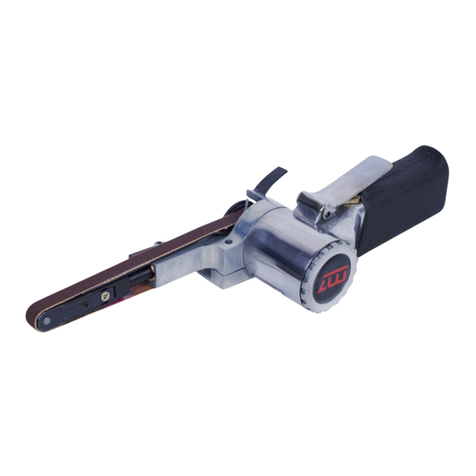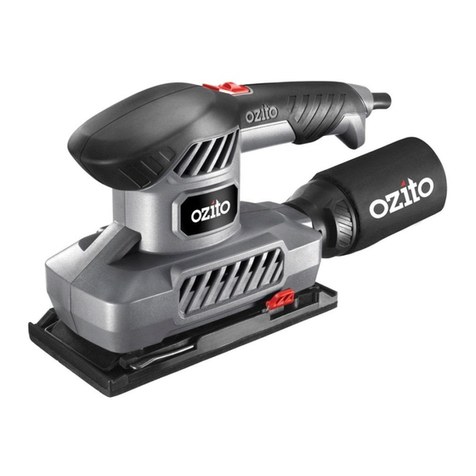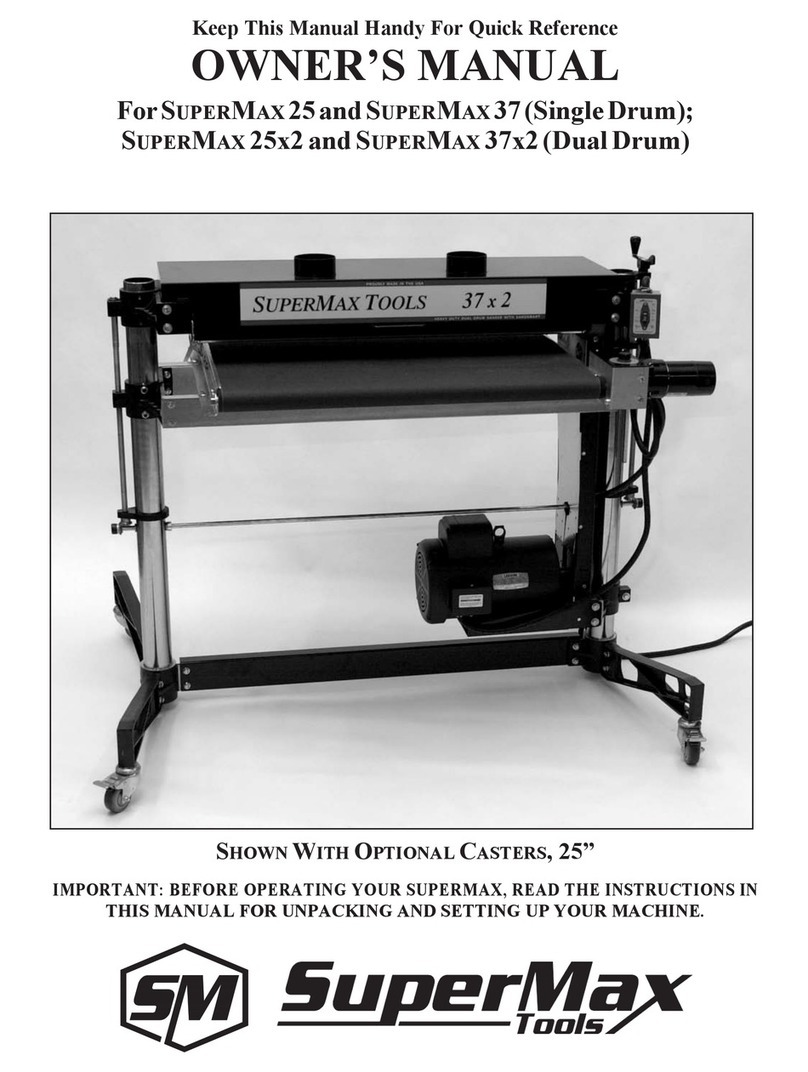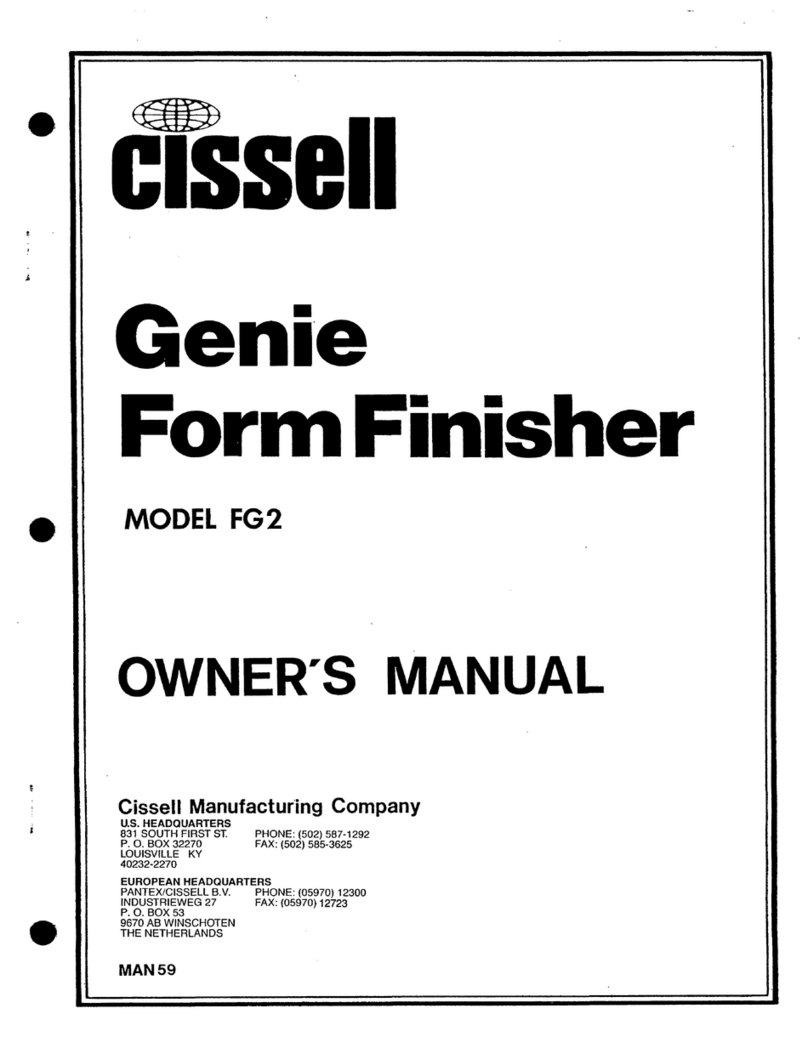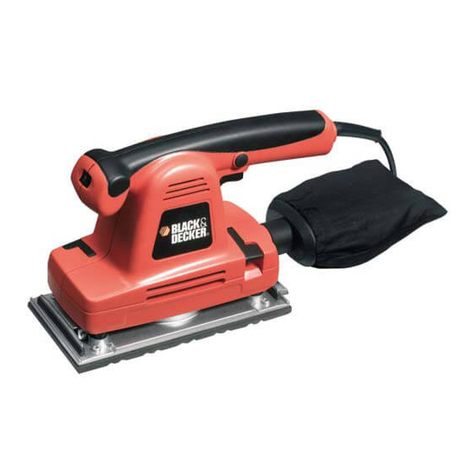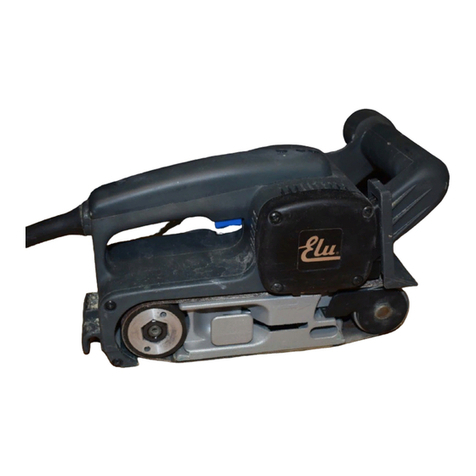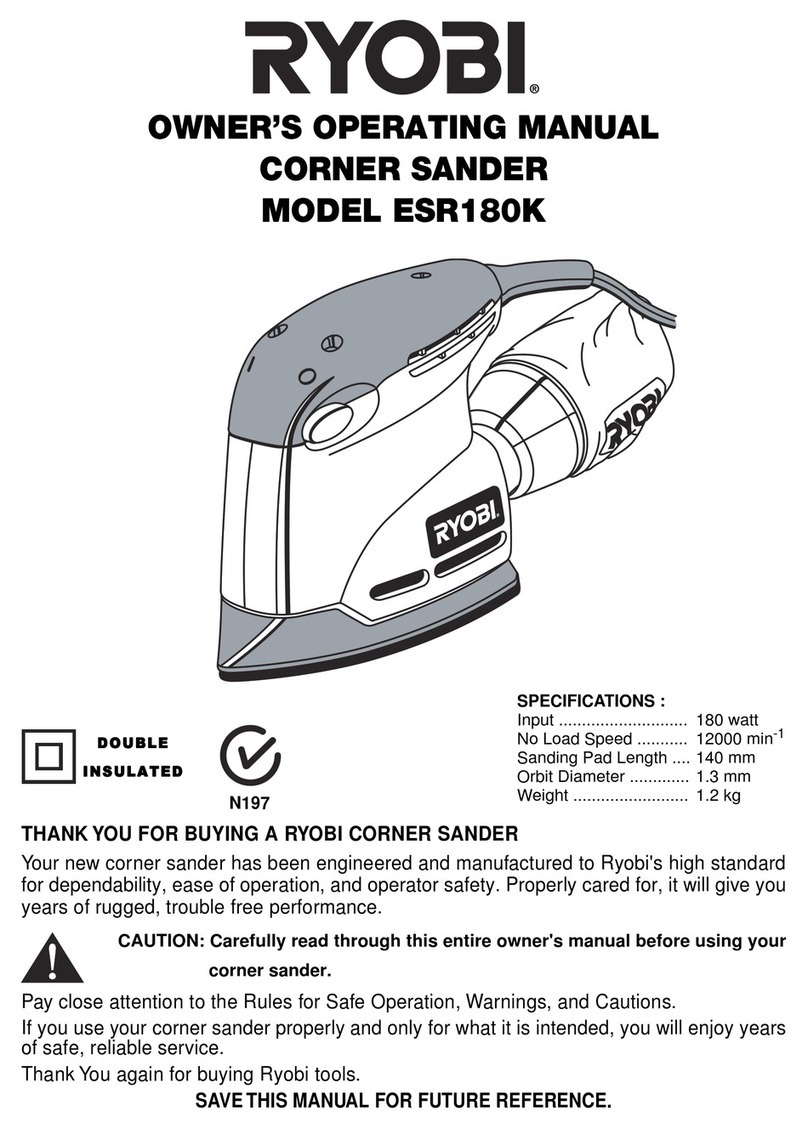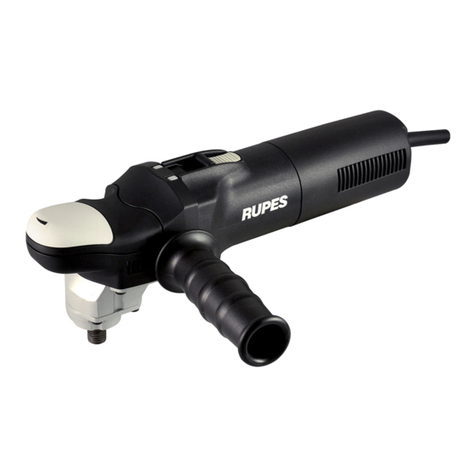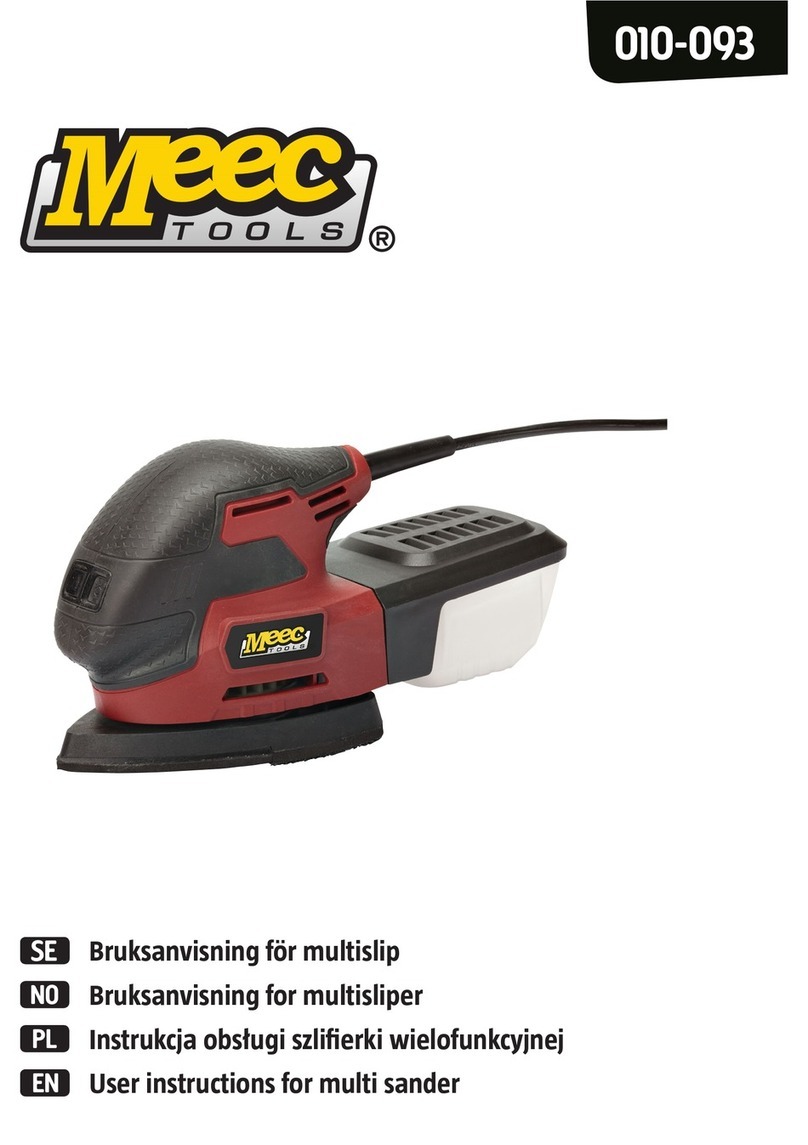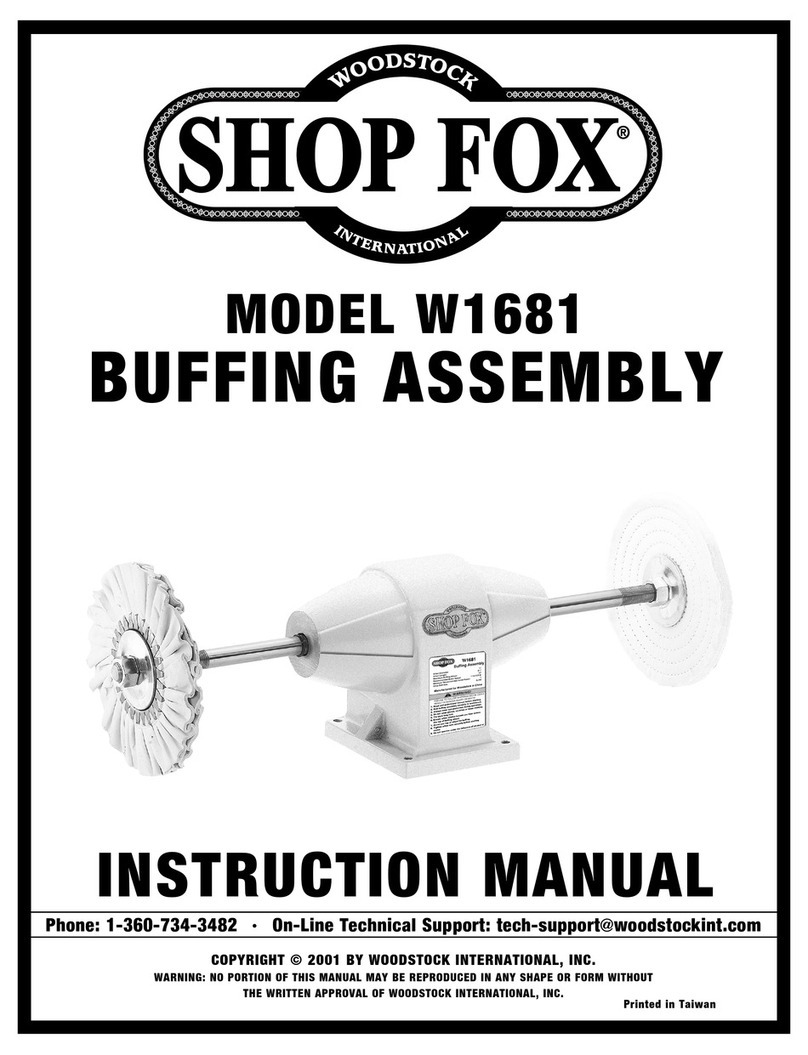Mighty Seven DOS-501 User manual

GENERAL SAFETY RULES
GENERAL POWER TOOL
SAFETY WARNINGS
WARNING: Read all safety
1. Keep the work area clean and well lit.
Cluttered or dark areas invite accidents.
2. Do not operate power tools in explosive
atmospheres, such as in the presence of
ammable liquids, gases or dust. Power
tools create sparks which may ignite the
dust or fumes.
3. Keep children and bystanders away
while operating a power tool. Distractions
can cause you to lose control.
ELECTRICAL SAFETY
1. Power tool plugs must match the
outlet. Never modify the plug in any way.
Do not use any adapter plugs with earthed
(grounded) power tools. Unmodified plugs
and matching outlets will reduce risk of
electric shock.
2. Avoid body contact with earthed
or grounded surfaces such as pipes,
radiators, ranges and refrigerators. There
is an increased risk of electric shock if your
body is earthed or grounded.
3. Do not expose power tools to rain or
wet conditions. Water entering a power tool
will increase the risk of electric shock.
4. Do not abuse the cord. Never use the
cord for carrying, pulling or unplugging the
power tool. Keep the cord away from heat,
oil, sharp edges or moving parts. Damaged
or entangled cords increase the risk of
electric shock.
5. When operating a power tool outdoors,
use an extension cord suitable for outdoor
use. Use of a cord suitable for outdoor use
reduces the risk of electric shock.
6. If operating a power tool in a damp
location is unavoidable, use a ground-fault
circuit interrupter (GFCI) protected supply.
Use of a GFCI reduces the risk of electric
shock.
PERSONAL SAFETY
1. Stay alert, watch what you are doing
and use common sense when operating a
power tool. Do not use the tool while tired
or under the inuence of drugs, alcohol, or
medication. A moment of inattention while
operating power tools may result in serious
personal injury.
2. Use personal protective equipment.
Always wear eye protection. Protective
equipment such as a dust mask, non-skid
safety shoes, hard hat, or hearing protection,
used for appropriate conditions, will reduce
personal injuries.
3. Prevent unintentional starting. Ensure
that the switch is in the off-position before
connecting to a power source and/or
battery pack, picking up or carrying the tool.
Carrying power tools with your finger on the
switch or energizing power tools that have
the switch on invites accidents.
4. Remove any adjusting key or wrench
before turning the power tool on. A wrench
or a key left attached to a rotating part of the
power tool may result in personal injury.
5. Do not overreach. Keep proper footing
and balance at all times. This enables better
control of the power tool in unexpected
situations.
warnings and instructions!
Failure to follow the warnings and instruc-
tions may result in electric shock, fire and /
or serious injury.
Save all warnings and instructions for
future reference.
The term “power tool” in the warnings refers
to your mains-operated (corded) power tool
or battery-operated (cordless) power tool.
WORK AREA SAFETY

6. Dress properly. Do not wear loose
clothing or jewelry. Keep your hair, clothing
and gloves away from moving parts. Loose
clothes, jewelry or long hair can be caught in
moving parts.
7. If devices are provided for the connection
of dust extraction and collection facilities,
ensure that these are connected and
properly used. Use of these devices can
reduce dust-related hazards.
POWER TOOL USE AND CARE
1. Do not force the power tool. Use the
correct power tool for your application. The
correct power tool will do the job better
and more safely at the rate for which it was
designed.
2. Do not use the power tool if the switch
does not turn it on and off. Any power tool
that cannot be controlled with the switch is
dangerous and must be repaired.
3. Disconnect the plug from the power
source and/or the battery pack from the
power tool before making any adjustments,
changing accessories, or storing power
tools. Such preventive safety measures
reduce the risk of starting the power tool
accidentally.
4. Store idle power tools out of the reach
of children and do not allow persons
unfamiliar with the power tool or these
instructions to operate the power tool.
Power tools are dangerous in the hands of
untrained users.
5. Maintain power tools. Check for
misalignment or binding of moving parts,
breakage of parts and any other condition
that may affect the power tool’s operation.
If damaged, have the power tool repaired
before use. Many accidents are caused by
poorly maintained power tools.
6. Keep cutting tools sharp and clean.
Properly maintained cutting tools with sharp
cutting edges are less likely to bind and are
easier to control.
7. Use the power tool, accessories,
tool bits, etc. in accordance with these
instructions, taking into account the
working conditions and the work to be
performed. Use of the power tool for
operations different from those intended
could result in a hazardous situation.
BATTERY TOOL USE
AND CARE
1. Recharge only with the charger
specified by the manufacturer. A charger
that is suitable for one type of battery pack
may create a risk of fire when used with
another battery pack.
2. Use power tools only with specifically
designated battery packs. Use of any other
battery packs may create a risk of injury and
fire.
3. When battery pack is not in use, keep
it away from other metal objects, like
paper clips, coins, keys, nails, screws or
other small metal objects that can make a
connection from one terminal to another.
Shorting the battery terminals together may
cause burns or a fire.
4. Under abusive conditions, liquid may
be ejected from the battery; avoid contact.
If contact accidentally occurs, flush with
water. If liquid contacts eyes, additionally
seek medical help. Liquid ejected from the
battery may cause irritation or burns.
SERVICE
1. Have your power tool serviced by a
qualied repair person using only identical
replacement parts. This will ensure that the
safety of the power tool is maintained.
GENERAL SAFETY RULES

SAFETY INSTRUCTIONS
The purpose of safety symbols is to attract your attention to possible dangers. The safety
symbols and the explanations with them deserve your careful attention and understanding.
The symbol warnings do not, by themselves, eliminate any danger. The instructions and
warnings they give are no substitutes for proper accident prevention measures.
WARNING: Be sure to read and understand all safety instructions in this manual,
including all safety alert symbols such as “DANGER,” ”WARNING,” and “CAUTION”
before using this tool. Failure to following all instructions listed below may result in
electric shock, re, and/or serious personal injury.
SYMBOL MEANING
SAFETY ALERT SYMBOL: Indicates DANGER, WARNING, OR CAUTION.
May be used in conjunction with other symbols or pictographs.
DANGER: Indicates an imminently hazardous situation, which, if not avoided,
will result in death or serious injury.
WARNING: Indicates a potentially hazardous situation, which, if not avoided,
could result in death or serious injury.
CAUTION: Indicates a potentially hazardous situation, which, if not avoided, could
result in minor or moderate injury.
NOTICE: (Without Safety Alert Symbol) Indicates a situation that may result in property
damage.
SAVE THESE INSTRUCTIONS!

SAFETY SYMBOLS
Some of these following symbols may be used on this tool. Please study them and learn their
meaning. Proper interpretation of these symbols will allow you to operate the tool better and
more safely.
Symbol Name Designation / Explanation
V Volts Voltage
A Amperes Current
Hz Hertz Frequency (cycles per second)
W Watts Power
∿Alternating current Type of current
�Direct current Type or characteristic of current
noNo-load speed Rotational speed at no load
lbs Pounds Weight
Class II construction Double insulated construction
.../min Per minute Revolutions, strokes, surface speed
orbits, etc., per minute
Wear safety goggles WARNING: The operation of any
power tool can result in foreign objects
being thrown into your eyes, which can
result in severe eye damage. Before
beginning power tool operation, always
wear safety goggles or safety glasses
with side shields and a full-face shield
when needed. We recommend a Wide
Vision Safety Mask for use over eye-
glasses or standard safety glasses with
side shields. Always use eye protection
which is marked to comply with
ANSI Z87.1.
WARNING: To ensure safety and reliability, all repairs should be performed by a
qualied service technician.

SPECIFIC SAFETY RULES
5. To reduce the risk of electric shock or
damage to the charger and battery, use
only the batteries and charger listed.
Battery pack Charger
DB-1850
6. Make sure the sandpaper is not
contacting the workpiece before the on/
off rocker switch is in the ON position.
7. Make sure the sander is off before
detaching the battery pack, check the
switch is off before attaching the battery
pack.
DANGER: People with electronic
devices, such as pacemakers, should
consult their physician(s) before using this
product. Operation of electrical equipment
in close proximity to a heart pacemaker
could cause interference or failure of the
pacemaker.
WARNING: Some dust created by
power sanding, sawing, grinding, drilling
and other construction activities contains
chemicals known to the state of California
to cause cancer, birth defects or other
re¬productive harm. Some examples of
these chemicals are:
• Lead from lead-based paints
• Crystalline silica from bricks and cement
and other masonry products, and
• Arsenic and chromium from chemically-
treated lumber.
Your risk from these exposures varies,
depending on how often you do this type
of work. To reduce your exposure to these
chemicals: work in a well ventilated area,
and work with approved safety equipment,
such as those dust masks that are specially
designed to filter out microscopic particles.
DB-1850P
DC-18A
SPECIFIC SAFETY WARNINGS
1. Hold power tools by insulated gripping
surfaces when performing an operation
where the cutting tool may contact hidden
wiring. Contact with a” live” wire will make
exposed metal parts of the tool live and
shock the operator.
2. Take protective measures when dust
can develop during working that is harmful
to one’s health, combustible or explosive.
Example: Some dusts are regarded as
carcinogenic. Wear a dust mask and work
with dust/chip extraction when connectable.
3. Use the machine only for dry sanding.
Penetration of water into the machine
increases the risk of an electric shock.
4. Secure the workpiece. A workpiece
clamped with clamping devices or in a vice
is held more secure than by hand.

SAFETY RULES FOR CHARGER
1) Before using battery charger, read all
instructions and cautionary markings in this
manual and on the battery charger, the battery
and the product using the battery to prevent
misuse of the products and possible injury or
damage.
CAUTION: To reduce the risk of electric
shock or damage to the charger and battery,
charge only those lithium-ion rechargeable
batteries as specifically designated on your
charger’s label. Other types of batteries may
burst, causing personal injury or damage.
2) Do not use the charger outdoors or expose it
to wet or damp conditions. Water entering the
charger will increase the risk of electric shock.
3) Use of an attachment not recommended or
sold by the battery-charger manufacturer may
result in a risk of fire, electric shock or injury to
persons.
4) Do not abuse the cord or charger. Never use
the cord to carry the charger. Do not pull the
charger cord to disconnect the plug from
receptacle. Damage to the cord or charger
could occur and create an electric shock
hazard. Replace damaged cords immediately.
5) Make sure that the cord is located so that it
will not be stepped on, tripped over, come in
contact with sharp edges or moving parts,
or otherwise subjected to damage or stress.
This will reduce the risk of accidental falls,
which could cause injury and damage to
the cord, which could then result in electric
shock.
6) Keep cord and charger from heat to prevent
damage to housing or internal parts.
7) Do not allow gasoline, oils, petroleum-based
products, etc. to come in contact with plastic
parts. These materials contain chemicals that
can damage, weaken, or destroy plastic.
8) An extension cord should not be used unless
absolutely necessary. Use of an improper
extension cord could result in a risk of fire
and electric shock. If an extension cord must
be used, make sure that:
The pins on plug of extension cord are the
same number, size and shape as those of the
plug on charger.
The cord is properly wired and in good electrical
condition
The size is large enough for AC ampere rating
of charger as specified below:
25’ 50’ 100’The Cord Length (Feet)
Cord Size (AWG) 1616 16
NOTE: AWG = American Wire Gauge
9) Do not operate the charger with a damaged
cord or plug, which could cause shorting and
electric shock. If damaged, have the charger
repaired or replaced by an authorized service
technician at Service Center.
10)Do not operate the charger if it has received
a sharp blow, been dropped, or has
otherwise been damaged in any way. Take
it to an authorized service technician at
Service Center for an electrical check to
determine if the charger is in good working
order.
11)Do not disassemble the charger. Take it to
an authorized service technician at a
Service Center when service or repair is
required. Incorrect reassembly may result in
a risk of electric shock or fire.
12)Unplug the charger from the electrical outlet
before attempting any maintenance or
cleaning to reduce the risk of electric shock.
13)Disconnect charger from the power supply
when not in use. This will reduce the risk of
electric shock or damage to the charger if
metal items should fall into the opening. It
will also help prevent damage to the charger
during a power surge.
14)Risk of electric shock. Do not touch the
uninsulated portion of output connector or
uninsulated battery terminal.
15)Save these instructions. Refer to them
frequently and use them to instruct others
who may use this tool. If you lend this tool to
someone else, also lend these instructions
to them to prevent misuse of the product and
possible injury.
WARNING: Some dust created by power Cutting
contains chemicals known to cause cancer,
birth defects or other reproductive harm. Some
examples of these chemicals are:
Ƶlead from lead-based paints
ƵArsenics and chromium from chemically
reacted lumber.
Your risk from these exposures varies, depending
on how often you do this type of work. To reduce
your exposure to these chemicals: work in a well
ventilated area, and work with approved safety
equipment
WARNING: Some dust created by power Cutting
contains chemicals known to cause cancer,
birth defects or other reproductive harm. Some
examples of these chemicals are:
Ƶlead from lead-based paints
ƵArsenics and chromium from chemically
reacted lumber.
Your risk from these exposures varies, depending
on how often you do this type of work. To reduce
your exposure to these chemicals: work in a well
ventilated area, and work with approved safety
equipment

FUNCTIONAL DESCRIPTION
OPERATING CONTROL
This tool is intented for sanding non humid surfaces.
1. MAIN PARTS
Vacuum
Adapter
Dust Bag
On/off
Switch
Base Pad

NOTE: Due to
change without prior notice.
Sound Pressure (dBA)
Sound pressure (Uncertainty K = 3 dB(A)) 82.2 dBA
Sound power level (Uncertainty K = 3 dB(A)) 95.7 dBA
Vibration level (m/s2)
(Uncertainty K = 1.5 m/s2)8.5 m/s2
SPECIFICATIONS
No-load Speed 7000~11000 OPM
Orbital Diameter 1/8” (3 mm)
Pad Size 5” (125 mm)
Weight 2 lb. 11 oz. (1.23 kg)

1. LED FUNCTIONS OF CHARGER
2. POWER BAR
This Lithium-Ion battery pack is equipped with a POWER BAR, which is used to display the battery
pack’s remaining run time. Press the POWER BAR button to display the LED lights. The LED lights
will stay lit for approximately 4 seconds.
NOTE: The POWER BAR can be used whether the battery is attached or removed from tool.
LED INDICATOR BATTERY PACK RED LED GREEN LED ACTION
HI/LO TEMP.
(SEE MANUAL) Hot/Cold battery On Off Charging will begin when
battery returns to 0oC-40oC
DEFECTIVE
BATTERY Defective Flashing Off Battery pack or Charger is
defective
BATTERY
CHARGING Charging Off Flashing Charging
BATTERY
FULL Fully charged Off On Charging is complete
Maintenance charging
3. LOW-BATTERY CAPACITY INDICATOR
gIf LED worklights on the POWER BAR begins
trigger switch on the wrench is depressed,
the battery pack’s power has run out, and the
battery pack should be recharged.
gUnlike other battery pack types, Lithium-Ion
battery packs deliver fade-free power for their
entire run time. The tool will not experience a
slow, gradual loss of power as you work. To
signal that the battery pack is at the end of its
run time and needs to be charged, the power
to the tool will drop quickly. The POWER BAR
when the battery is completely discharged.
When this happens, remove the tool from the
workpiece, and charge the battery pack as
needed.
NOTE: The POWER BAR may also display four
temperature situation.
4. WHEN TO CHARGE THE
BATTERY PACK
GJH/!3
80-100% Charge
60-79% Charge
40-59% Charge
20-39% Charge
Under 20% Charge
Completely Discharged
High/low temperature
The Lithium-Ion battery can be charged at any
time and will not develop a “memory” when
charged after only a partial discharge. It is not
necessary to run down the battery pack charge
before recharging. Remove the battery pack
from the tool when convenient for you and your
job.
gUse the POWER BAR to determine when you
need to recharge the battery pack.
gYou can “top-off” your battery pack’s charge
before starting a big job or long period of use.

ASSEMBLY
ASSEMBLY
TO ATTACH BATTERY
PACK (FIG. 1)
Make sure that the sander is switched
off. Align the raised rib on the battery pack
with the grooves on the sander, and then
slide the battery pack onto the sander.
NOTICE: Make sure that the latch
on the battery pack snaps into place
and the battery pack is secured to
the sander before operation.
TO DETACH BATTERY
PACK (FIG. 1)
1. Make sure that the sander is
switched off.
2. Depress the battery-release
buttons located on the front of the
battery pack to release the battery
pack.
3. Pull the battery pack out and
remove it from the sander.
Release Button
Attach
Detach
FIG. 1
WARNING: If any part is broken
or missing, DO NOT attempt to attach the
battery or operate the tool until the broken
or missing part is replaced. Failure to do
so could result in possible serious injury.
WARNING: Do not attempt to
modify this tool or create accessories not
recommended for use with this tool. Any
such alteration or modication is misuse
and could result in a hazardous condition
leading to possible serious injury.
WARNING: Your tool should never
be connected to the battery when you are
assembling parts, making adjustments,
installing or removing blades, cleaning, or
when it is not in use. Disconnecting the
tool will prevent accidental starting, which
could cause serious personal injury.
UNPACKING
1. Carefully remove the tool
and any accessories from the
carton. Make sure that all items
listed in the packing list are
included.
2. Inspect the tool carefully to
make sure that no breakage or
damage occurred during
shipping.
3. Do not discard the packing
material until you have
carefully inspected and
satisfactorily operated the tool.

OPERATION
TO ATTACH VACUUM
ADAPTOR (FIG. 2)
The vacuum adapter allows you to connect
a 2-1/2 in. diameter vacuum hose to help
keep the work area clean.
To install:
1. Detach the battery pack from the
sander.
2. Align the raised rib of the dust-exhaust
port with the groove of the vacuum
adaptor (FIG. 2).
3. Slide the vacuum adaptor forward and
push it onto the dust-exhaust port until
it is firmly seated.
NOTICE: From time to time, clean the vac-
uum adaptor with a dry brush.
To remove:
1. Detach the battery pack from the
sander.
2. Grip the adaptor firmly and pull it out
from the tool.
Groove
Raised Rib
FIG. 2
ATTACHING THE DUST BAG
TO THE ADAPTOR
WARNING: Do not use the dust
bag when sanding metal. Using the dust bag
when sanding metal creates a fire haz-ard, which
could damage the tool and lead to serious
personal
WARNING: Collected sanding dust
from sanding surface coatings such as
polyurethanes, linseed oil, etc., can self-ignite
in the sander dust bag or elsewhere and cause
fire. To reduce the risk of fire, al-ways empty the
dust bag frequently while sanding and never
store or leave a sander without totally emptying
its dust bag. Also follow the recommendations of
the coating manufacturers.
Your sander is supplied with a dust-
collecting bag to help you keep the working area
clean. The dust bag is ideal for smaller jobs.
To install:
1. Detach the battery pack from the
sander.
2. Align the indicators on the vacuum
adaptor and the dust bag.
3. Slide the dust bag forward and push it
onto the adaptor. Rotate the bag
clockwise to lock it in place (FIG. 3).
Lock
Unlock
Indicators
FIG. 3

OPERATION
NOTICE: From time to time, remove the
dust bag from the sander and clean the
dust bag with a dry brush.
To remove:
1. Detach the battery pack from the
sander.
2. Grip the dust bag firmly, rotate it
counterclockwise, and pull it out from
the tool (FIG. 3).
ATTACHING THE SANDPAPER
WARNING: Always inspect the
sandpaper before attaching it to the sand-
er. Do not use the paper if it is torn or de-
fective.
1. Detach the battery pack from the
sander.
2. Place the sander upside down on a flat
surface.
3. Remove any dust or debris from the
sanding pad.
4. Align the holes of the sandpaper with
the holes in the sanding pad and firmly
press the sandpaper against the sanding
pad to ensure a good attachment.(FIG.
4)
SELECTING THE SANDPAPER
GRADE
• Different grades of sandpaper can be
purchased from the store where you
purchased the tool.
• Available grades are: Coarse, Medium
and Fine.
• Use a coarse grit to sand rough finishes,
medium grit to smooth the work, and fine
grit for finish sanding.
• It is best to make a trial run on a scrap
piece of material to determine the
optimum grades of sandpaper for a
particular job.
FIG. 4

OPERATION
TURNING THE SANDER ON/OFF
(FIG. 5)
To turn on the sander, depress the side of the
rocker switch marked “I”.
To turn it off, depress the side of the rocker
switch marked “O”.
VARIABLE-SPEED
DIAL (FIG. 6)
The variable-speed feature on this sander
allows you to match the proper speed to the
material being sanded.
1. The variable-speed dial is used to adjust the
speed of the sander.
2. Turn the dial to increase or decrease the
speed of the tool (FIG. 6).
3. Position “1” selects the slowest
speed; position “6” selects the fastest
speed. Adjust the speed for optimum
performance.
SANDING
This sander can be used for most sanding
operations on materials such as wood,
plastic, and painted surfaces. Do not use
this sander for wet sanding.
1. Attach the battery.
2. Place the sander on the workpiece so
that the sandpaper is fully in contact
with the workpiece.
3. Start the sander.
4. For best sanding results, apply light
pressure on the sander, but do not force
the tool.
5. Move the sander slowly over the
workpiece, making successive passes
in parallel lines, circles, or crosswise
movements. The removal rate and the
sanding pattern are determined by the
choice of sandpaper and the material
being sanded.
6. Do not sand in one spot too long, as the
sander’s rapid action may remove too
much material and make the surface
uneven.
7. Upon completion of the sanding
operation, remove the sander from the
workpiece, turn the sander off and wait
until it comes to a complete stop before
putting it down.
FIG. 5
Variable-speed
Dial
FIG. 6

WARNING: Always wear safety
goggles or safety glasses with side shields
during power tool operations, or when
blowing dust. If operation is dusty, also
wear a dust mask.
WARNING: Do not at any time let
brake uids, gasoline, petroleum-based
products, penetrating oils, etc. come in
contact with plastic parts. Chemicals can
damage, weaken or destroy plastic, which
may result in serious personal injury.
MAINTENANCE
From time to time, remove the dust bag from
the sander and clean the dust bag with a dry
brush.
The tool may be cleaned most effectively
with compressed dry air. Always wear
safety goggles when cleaning tools with
compressed air.
Avoid using solvents when cleaning plastic
parts. Most plastics are susceptible to
damage from various types of commercial
solvents and may be damaged by their use.
Use a clean cloth to remove dirt, dust, oil,
grease, etc.
BEFORE EACH USE
1. Inspect the sander, the on/off switch
and the accessories for damage.
2. Check for damaged, missing, or worn
parts.
3. Check for loose screws, misalignment
or binding of moving parts, or any other
condition that may affect the operation.
4. If abnormal vibration or noise occurs,
turn the tool off immediately and have
the problem corrected before further
use.
5. Detach the battery from the sander
before cleaning or performing any
maintenance. Using compressed air
may be the most effective cleaning
method.
MAINTENANCE
6. Always wear safety goggles when
cleaning tools using compressed air.
LUBRICATION
All of the bearings in this tool are lubricated
with a sufficient amount of high grade
lubricant for the life of the unit under normal
conditions. Therefore, no further lubrication
is required.
REPLACE THE BASE PAD
1. Remove four screws on the base pad,
and then detach the cap from the base
pad.
2. Align four holes on the cap with four
holes on the base pad, and then insert
the cap into the new base pad.
3. Place the new base pad on the cap base
with four holes on the base pad aligned
with four holes on the cap base.
4. Retighten four screws on the base pad.
NOTICE: Sanding pad can be a
replacement for the pad of this random
orbital sander.
WARNING: Detach the battery
from the sander before replacing the base
pad.
Screw
Base Pad
Cap
Cap Base
FIG. 7

MAINTENANCE
The tool may be cleaned most effectively
with compressed dry air. Always wear
safety goggles when cleaning tools with
compressed air.
Avoid using solvents when cleaning plastic
parts. Most plastics are susceptible to
damage from various types of commercial
solvents and may be damaged by their use.
Use clean clothes to remove dirt, dust, oil,
grease, etc.
BEFORE EACH USE
1. Inspect the Sander,the on/off switch
and the accessories for damage.
2. Check for damaged, missing, or worn
parts.
3. Check for loose screws, misalignment
or binding of moving parts, or any other
condition that may affect the operation.
4. If abnormal vibration or noise occurs,
turn the tool off immediately and have the
problem corrected before further use.
5. Detach the battery from the Impact
Wrench before cleaning or performing any
maintenance. Using compressed air may
be the most effective cleaning method.
Always wear safety goggles when
cleaning tools using compressed air.
LUBRICATION
All of the bearings in this tool are lubricated
with a sufficient amount of high grade
lubricant for the life of the unit under normal
conditions. Therefore, no further lubrication
is required.
OPERATION
1.BATTERY CHARGING
The battery is supplied partially charged. To
ensure full capacity of the battery,
completely charge the battery in the battery
charger before
A fully discharged battery pack will charge
in 50 minutes for DB1850 in a surrounding
temperature between 32° F (0° C) and 104°
F (40° C).
1. Charge the Lithium-Ion battery pack with
the correct charger.
2. Connect the charger to a power supply.
3. Align the raised ribs of the battery pack
with the slot in the charger.
4. Slide the battery pack onto the charger .
5. The charger will communicate with the
battery pack to evaluate the condition of the
battery pack.
6. The POWER BAR LED lights will cycle
from right to left during charging. This is part
of the normal charging operation.
7. After charging is complete, the green LED
on the charger will come on and the POWER
BAR LED lights will go displayed when the
POWER BAR button is pressed while the
battery pack is on the charger.
8. The battery pack will fully charge if left on
the charger, but it will not overcharge.
NOTE: For your convenience, the charger
can operate with most generators and
inverters rated at 300 watts or higher.

TROUBLESHOOTING
ACCESSORIES
NO
PROBLEM CAUSE SOLUTION
The sander does not work. The battery is depleted. Charge the battery.
The sander doesn’t collect
the dust as expected.
The dust bag is full. Clean the dust bag.
The sandpaper is not
properly attached and the
holes are not aligned.
Reattach the sandpaper with
the holes properly aligned.
ENVIRONMENT PROTECTION
1. Tool, accessories and packaging should be sorted for environment-friendly
recycling.
2. Power tools and accessories at the end of their service life still contain
large amounts of valuable raw materials and plastics which can likewise be
fed back into a recycling process.
3. Some dust created by working contains harmful chemicals must be
collected by special garbage re- cycle site.
SERVICE
1. In case of warranty, repair or the purchase of spare parts, always contact
an authorized service center. Attach the service card and the invoice.
2. The warranty does not cover normal wear, overloading or abnormal use of
the product.




Table of contents
Languages:
Other Mighty Seven Sander manuals
